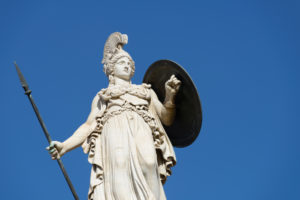 If you’re familiar with Greek mythology, you probably know about most of the major deities in the religion: Hera, Athena, Demeter, Zeus, Poseidon, and so forth. You probably also know that many of these have Roman equivalents such as Juno, Minerva, Ceres, Jupiter, and Neptune. Did the ancient Romans rip off their Greek counterparts to construct their own pantheon of deities? The answer to that question is a bit more complex than you may think.
If you’re familiar with Greek mythology, you probably know about most of the major deities in the religion: Hera, Athena, Demeter, Zeus, Poseidon, and so forth. You probably also know that many of these have Roman equivalents such as Juno, Minerva, Ceres, Jupiter, and Neptune. Did the ancient Romans rip off their Greek counterparts to construct their own pantheon of deities? The answer to that question is a bit more complex than you may think.
Hellenistic Influences on Religion in the Ancient Near East
When one hears the term “Hellenization,” it’s usually within the context of a discussion about Greek influences on Jewish civilization after the end of the fourth century B.C.E. In truth, Greek cultural impacts spread far and wide, as Yale Divinity School professor Harold W. Attridge explained in an interview on PBS’s Frontline website. Alexander the Great’s conquests included lands from India to Egypt and resulted in four political entities in their aftermath:
- The Ptolemaic kingdom of ancient Egypt
- The Seleucid Empire covering portions of western India, Mesopotamia, and Asia Minor
- The tiny Attalid-ruled kingdom of Pergamon, now in present-day Turkey
- The Antigonid-ruled lands of Macedonia, Asia Minor and Syria
Yet it was not Alexander’s military expansion that caused Greek ideas to make significant inroads into Roman religion. Ancient History Encyclopedia contributor Mark Cartwright reveals that Greek colonists began settling on the southern coasts of the Italian Peninsula and parts of Sicily during the eighth century B.C.E. Over the next three centuries, these colonies collectively developed into a region known as Magna Graecia. When native populations encountered the denizens of these city-states, they ultimately adopted Greek ideas into their own daily lives.
The Romans Take Over
Through a series of wars and conquests, the Roman Empire slowly grew from its eponymous city-state and engulfed the rest of the Italian Peninsula. As it expanded southward, it absorbed the Etruscan, Celtic, and Greek civilizations that lay in its wake. In another Ancient History Encyclopedia article, history professor Donald L. Wasson discloses that the Romans usually did not impose their own religions upon the peoples they conquered. In fact, they incorporated Greek and Etruscan ideas into their own mythologies, blending their own deities with those from subject civilizations.
This syncretizing transformed what was originally an animistic belief system into a religion with an expansive pantheon of anthropomorphic deities. However, Wasson details that the ancient Romans placed a greater emphasis on rituals, which was markedly different than Greek approaches to religion. Their focus on ritualistic performance was similar to that of the Etruscans before them, as the Encyclopedia Britannica clarifies. At the same time, the ancient Romans also included more Greek rites and practices.
Roman Deities and the Capitoline Triad
Once the ancient Romans imported Greek deities into their religious practices, several of these figures rose in status and became major gods and goddesses. Probably the most recognized of these is Jupiter, whom the Romans equated with the Greek Zeus. As a sky god and protector, he was regarded as the king of the gods and reigned along with his wife Juno, equated with Hera and ruling as a goddess of light, the moon, fertility, childbirth, and motherhood. Another highly regarded deity was their daughter Minerva, the equal of the Greeks’ Athena and serving as the goddess of education, commerce, industry, and eventually war. These three were known as the Capitoline Triad, since they were revered with a major temple located on Rome’s Capitoline Hill.
When deities are known by multiple names in different cultures, it can become a little confusing. Nevertheless, it’s evidence of how ideas can become transformed when they’re transmitted across cultural boundaries. Whether you regard the ancient Romans’ borrowing of Greek deities as friendly admiration or an appropriative move, it’s another example of how artifacts from one civilization can easily become part of another.

